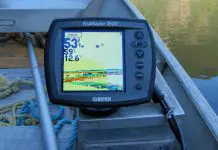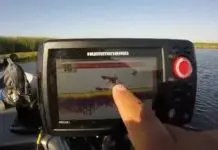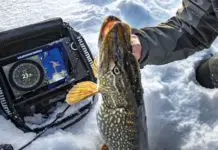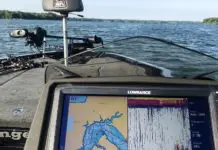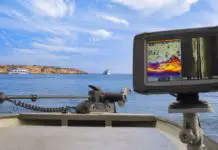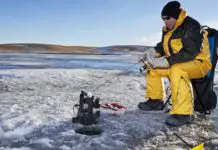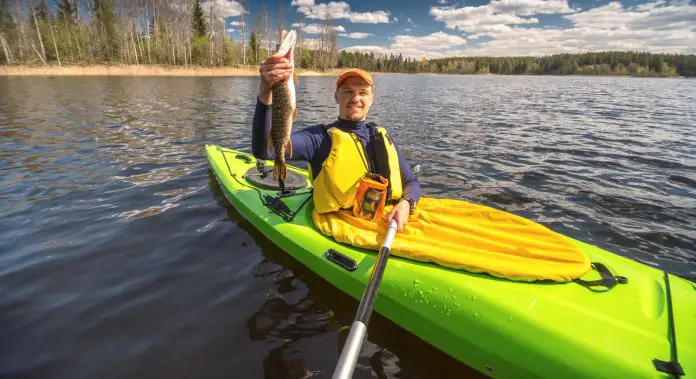
There is no experience like battling with a fish on your line. It brings out a primal rush of adrenaline as you grapple with a wild animal that is fighting for its life.
Fishing from the shore is awesome, but when you’re in a kayak and being towed along by a ten-pound trout, that feeling of excitement is multiplied one hundred times.
The thrill and buzz you get from kayak fishing is difficult to describe, and I recommend that everybody try it for themselves.
If you’ve never fished from a kayak before, I’ve put together this guide to get you out on the water as fast as possible. Fish on!
Skills Required and How to Learn
Kayak fishing is a mixture of two unique skill sets; fishing and basic boating. Each skill is vastly different from the other and has its own intricacies. There is quite a lot to learn in the beginning, especially if you’ve never tried either sport before.
My advice would be to try each activity on its own before trying to combine them.
Speak with mates that do either activity and see if you can tag along for a day.
Even the most uncoordinated person will be able to balance a kayak and maneuver it within 30 minutes of guided paddling instruction.
In my opinion, fishing is the harder of the two skills to learn, and you’ll need at least a whole afternoon with your rod in hand. You may get the hang of casting soon enough, but the opportunities for striking and reeling in fish are often few and far between.
Once you feel confident that you know the basics of each activity, it’s time to combine them on the water. Again, take it easy and stick to what you’ve been taught. This often means remaining seated and practicing small casts to the side.
Be aware of your movements and try not to move too suddenly. New kayak anglers often end up going for a dip reaching around to grab something from behind.
Check these suggestions:
5 Awesome Advantages of Kayak Fishing
Kayak fishing is rapidly gaining popularity, but what’s all the fuss about?
Well, kayak fishing has several advantages over fishing from the bank or boat, and anglers get hooked after giving it a go. Let’s explore some of the benefits of kayak fishing in more detail:
- Inexpensive hobby – While the initial cost of getting started kayak fishing can be high, the equipment will last a lifetime, and the ongoing costs are low to nil.
- Access difficult fishing locations – The compact and agile kayak can explore waters that can’t be accessed by foot or by larger fishing boats.
- Reduced noise – You won’t spook fish by the loud and unusual sound created by large engines.
- No pollution – Provided you opt not to use a motor, kayak fishing is an environmentally friendly activity.
- Health and fitness – The greatest benefit of paddling, is how it makes you feel when you’re on the water. You come alive with exercise and have a deep-rooted feeling of contentment playing in nature.
Must Haves for New Kayak Anglers
I’ll be up front with you; there is a lot of equipment required for kayak fishing. It’s not like running, where you could buy a pair of cheap shoes and away you go.
Even if you stick to lower-spec equipment catered for beginners, I estimate the total cost of getting started to be around $1,000 (broken down below). However, this figure can be higher if you opt for premium goods, or cheaper if you buy used.
Let’s look at the essential items you’ll need to get started.
- Kayak – Kayaks come in all shapes and sizes depending on the waters they’ll be used in and the paddling activity.
Fishing kayaks are available in sit-on-top models that are predominantly for flat, slow-moving rivers and lakes, and enclosed sit-in versions for coastal and tidal regions where there will be waves.
The kayak that best suits you will be determined by the waters you frequent most. Your local paddle shop will be able to advise on a suitable kayak if you explain where you intend on paddling.
Beginners will want to stick to a sit-on-top kayak that is easy to bail out of, and that has a broad and flat bottom as these are the most stable in the flat water conditions newbies will find themselves in. Extra wide kayaks will also allow you to stand up and sight fish if you would like that option.
Cost estimate: $500
- Paddle – You’re not going to get far without your paddle, but while paddles are essential, there’s no need to splurge on an expensive one in the beginning.
If your kayak comes with a basic paddle, that will do just fine. If not, an adjustable, aluminum shaft paddle with plastic blades is all that’s required.
Cost estimate: $40
- Fishing Rod – like kayaks, the cost of fishing rods can vary widely. If you speak to someone at your local tackle shop, they’ll be able to kit you out with a rod, reel, and line that are suitable for the species you’ll be fishing.
You’ll also need a small selection of lures, but you can pass on a net if you’re on a budget.
Cost estimate: $200
- PFD (life vest) – A Personal Flotation Device (PFD) is like your seat belt. You should be wearing it every time you’re on the water. Your life vest is your most important piece of kayak safety gear and is a must have no matter how confident a swimmer you are.
Cost estimate: $80
- Fishing License – You can be fined thousands of dollars and possibly issued a fishing ban if you’re caught fishing without a permit. At a couple of hundred dollars for a whole season license, it’s not worth risking it.
Cost estimate: $200
- Optional Extras – Rod holders, fish finders, filleting station, and cool boxes all add functionality to your boat and create a more enjoyable fishing experience.
Cost estimate: $50-$5,000+
There is no end to the amount of extras you can add to your yak. However, don’t get carried away until you’re more experienced and know exactly what it is that you want. And as you’ll see below, there is more than one way to modify your kayak.
Getting Tricky: How to Customize Any Kayak for Fishing
Not everyone has $1,000 to blast on kayak fishing gear. Lucky for you, just about any old, beaten-up kayak or canoe can be kitted out for fishing. Here’s how:
- Upgrade Your Seat – As you’ll be parked on your ass for hours at a time, one of the first mods I suggest you carry out is upgrading to a well-padded seat. Deluxe seats often have zipped compartments on the back offering extra storage.
- Additional Rod Holders – Most fishing kayaks come with several flush-mounted rod holders molded into the body. But if you’ve not got a purpose built fishing kayak, there’s no need to fret. Rod holders can be added easily with some basic DIY skills. A couple of flush-mount rod holders either side on the top deck, or one adjustable rod holder in the center of the deck should do the trick.
- Cool Boxes – Cool boxes can keep your drinks and snacks cold and can also be modified to act as a live well to keep live bait fresh.
- Get a Milk Crate – There’s nothing special about milk crates, however, they’re very handy for providing additional storage and for attaching additional vertical rod holders.
None of the above mods cost a fortune to install. Modifying your yak can be as cheap or as expensive as you like. Here’s a great video on how to transform a regular kayak into a fishing kayak on the cheap.
Conclusion
Hopefully, I’ve managed to convince another angler to get out on the water. You now know the core competencies and equipment required, and it’s now just a case of practicing your craft.
If you don’t feel confident giving kayak fishing a go by yourself, seek to tag along with friends, or ask the guys at the tackle shop to take you out for your first time, or pay for a kayak fishing tour.
The most important thing is just to get out and fish on your kayak and experience firsthand how awesome this sport is.
























